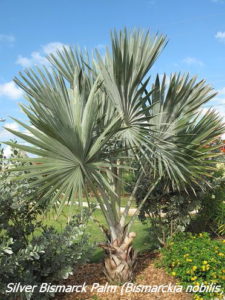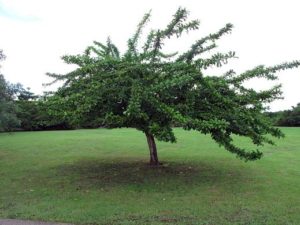Lying on a beach under the shade of the waving fronds of a coconut tree….nothing says relaxation better than this image. Pinch me; am I really in the Caribbean? I look up and admire the way the leaves hang so languidly. During this vacation, I have taken every opportunity to go exploring beyond the hotel compound and ask questions about tropical trees and exotic flowers. In the process, I have stumbled upon the strange and wonderful world of palm trees and fallen madly in love.
I see them so differently than I first did, when I thought of them as all the same. Every child can draw a generic palm tree but why is that so? Simple! A palm tree (any plant of the family Palmae or Arecaceae) has a cylindrical stem and no branches, simply large leaves coming from the crown. The stem can be smoothor it can be patterned with scars of the leaves which have fallen off. The leaf shape can be pinnate (feather-like or having smaller leaves on either side of a stem) or palmate (like the palm of the hand, having five or more lobes whose midribs all radiate from a single point). All palm trees are monocotyledonous. There is a single leaf inside the embryonic seed as it forms. However, this simple description doesn’t tell the whole story. Palm trees come in a variety of shapes, sizes, colours and growing habits.

After deliberation, I have narrowed my list to three favourite palms. The first pinnate is the sturdy Foxtail Palm(Wodyetia bifurcate). Feathery green leaves, looking just like the tail of its namesake, the fox, arch gracefully from a smooth, slender stem. Reputedly the world’s most widely-used landscape palm, foxtails are planted in sunny boulevards and along roads as they are resistant to pollution and easy to grow in most soils and situations. This native of Australia, which can achieve a mature height of 25 to 30 feet, looks wonderful in groups.
The Areca palm (Chrysalidocarpus lutescens), also a pinnate, is familiar to North Americans. It’s widely used in malls and offices to disguise an unsightly area or fill unneeded space. Tropical gardeners will plant an Areca to give a feeling of privacy without blocking the view. Many slim yellow stems grow in a tight cluster, similar to the way bamboo grows. The Areca palm grows best in partly shaded environments, and can reach a height of 30 feet.
The massive Silver Bismarck Palm (Bismarckia nobilis), a native of Madagascar, is the most majestic of the three. This striking gray-blue tree has large stiff palmate leaves shaped like stars at the end of stalks as long as 6 feet. Eventually, the Bismarck resembles a gigantic flock of birds or a collection of fans, especially when viewed on a breezy day. As the leaves split off or are pruned off, the stout base of the tree develops a criss-cross design from the scars because they are attached to the stem in a spiral pattern. Landscape designers place one or two Bismarcks at the entrance of a grand hotel or villa for great impact. This palm definitely creates a sense of arrival. It starts off slowly but picks up speed once established in a mostly sunny spot. At maturity, it is known to grow to 40 feet or more tall and 30 feet wide.
I feel as if I’m about to fall asleep under the tree. Some say that to dream of palm trees is a sign of hope and peace. I can understand why.


 The Spanish were astounded by the abundance of flora and asked the Taino about everything in sight. Many Taino words are still commonly used today: guava, annatto, guinep, tobacco, potato, papaya, and cacao. The coastline and ferny vine-covered forests were rich with exotic fruit: sweetsop, soursop, custard apple, sea grape, star apple, and naseberry. Every tree and plant had a use, whether for medicine, seasoning, preserving, and body paint or hallucinogens. Wild plantain (Heliconia caribatea) leaves were used for thatch roofing. One unusual tree is the calabash (Crescentia cujete); its strong branches reach out in all directions, holding the big round fruit close. Since Taino times, the ripe fruit has been dried to make bottles, scoops and musical instruments. Columbus was amazed by the Tainos’ elaborate 50 foot canoes made from enormous silk cottonwood trees (Ceiba pentandra). Each canoe held up to one hundred men; it’s clear that they traveled easily between islands.
The Spanish were astounded by the abundance of flora and asked the Taino about everything in sight. Many Taino words are still commonly used today: guava, annatto, guinep, tobacco, potato, papaya, and cacao. The coastline and ferny vine-covered forests were rich with exotic fruit: sweetsop, soursop, custard apple, sea grape, star apple, and naseberry. Every tree and plant had a use, whether for medicine, seasoning, preserving, and body paint or hallucinogens. Wild plantain (Heliconia caribatea) leaves were used for thatch roofing. One unusual tree is the calabash (Crescentia cujete); its strong branches reach out in all directions, holding the big round fruit close. Since Taino times, the ripe fruit has been dried to make bottles, scoops and musical instruments. Columbus was amazed by the Tainos’ elaborate 50 foot canoes made from enormous silk cottonwood trees (Ceiba pentandra). Each canoe held up to one hundred men; it’s clear that they traveled easily between islands.